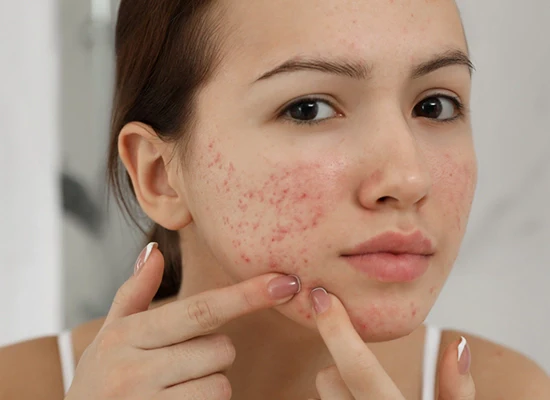What Non-Comedogenic Ingredients Mean for Acne-Prone Skin
Non-Comedogenic Ingredients don’t have to be oil-free they can include oils like jojoba or safflower oil. These oils appear

Non-Comedogenic Ingredients don’t have to be oil-free they can include oils like jojoba or safflower oil. These oils appear to be less likely to block pores compared to coconut oil.
Many of us utilize skin-care products to enhance and maintain the health and appearance of our skin. When it comes to cosmetics, the goal is often to improve how we perceive our looks in some manner (and let’s not forget that experimenting with makeup can be simply enjoyable and uplifting).
Therefore, the last thing you would want to do is knowingly use a product that could lead to acne breakouts, right? This is where the idea of comedogenicity and Non-Comedogenic Ingredients products comes into play.
To understand what “comedogenic” means, it helps to recognize that comedones are bumps that result from clogged pores. An open comedo, which is a single comedone, appears as a blackhead, while a closed comedo is known as a whitehead.
A ‘comedo’ is the fundamental lesion of acne, and ‘genic’ refers to causing,” explains board-certified dermatologist Chris Adigun, MD, FAAD. “Thus, ‘comedogenic’ essentially translates to acne-causing.” Conversely, an ingredient deemed Non-Comedogenic Ingredients should not obstruct your pores.
What Does “Non-Comedogenic” Mean?
The term non-comedogenic refers to skincare and makeup products that are specially designed to prevent pore clogging, which can lead to comedones (the scientific term for clogged pores). When pores become blocked, they can develop into blackheads, whiteheads, or acne.
Hence, Non-Comedogenic Ingredients products are formulated to avert this issue, utilizing lightweight ingredients that cater to the needs of acne-prone or sensitive skin to minimize the likelihood of breakouts.
Why Non-Comedogenic is Essential for Acne-Prone Skin

Reduces Breakout Risk
Skin prone to acne is especially sensitive to congestion from products containing heavy oils or thick consistencies. Non-Comedogenic Ingredients options provide hydration and nourishment without obstructing pores, thus lowering the chances of new breakouts occurring.
Supports the Skin’s Natural Equilibrium
Acne-prone skin thrives on a balanced routine—sufficient moisture without excessive oil accumulation. Typically, non-comedogenic products are more lightweight, aiding in maintaining the skin’s natural equilibrium instead of overwhelming it, which is vital for controlling acne and sensitivity. It is also important to ensure adequate hydration, as excessively drying out acne-prone skin can also lead to breakouts.
Reduces Inflammation
For individuals with sensitive, acne-prone skin, inflammation can be easily triggered by ingredients that clog pores. Using Non-Comedogenic Ingredients products can minimize irritation, helping to alleviate redness, swelling, and the overall intensity of breakouts.
Finding Non-Comedogenic Products
Since the term “non-comedogenic” is not strictly regulated, not every product marketed as such is guaranteed to be pore-friendly. Here are some tips to consider:
Avoid Heavy, Pore-Clogging Ingredients
Steer clear of components like mineral oil, lanolin, and even coconut oil if you’re prone to breakouts. These thicker ingredients can lead to pore blockage.
Opt for Skin-Balancing Oils
Not all oils are pore-clogging. Ingredients such as squalane, jojoba, hempseed oil, and rosehip oil are recognized for their non-comedogenic properties and can help regulate the skin’s natural oil production, making them suitable for acne-prone skin.
Creating a Non-Comedogenic Skincare Routine
A simple skincare routine focused on Non-Comedogenic Ingredients products can greatly benefit those with acne-prone skin. Here are the key components:
- Gentle Cleanser: Use a sulfate-free cleanser that effectively eliminates impurities without stripping away moisture. H&Z’s top-selling Purifying Cleanser is an excellent choice for those new to oil cleansers, as it cleanses and nourishes without removing essential natural oils.
- Hydrating Serum: Light serums containing components like hyaluronic acid or niacinamide offer moisture without clogging pores. Both the MiracleFirm Smoothing Serum and the Hydrating Gel Toner are excellent options to consider for your skincare routine. While the gel toner is not a serum, it is still rich in hyaluronic acid and aloe vera, making it an excellent hydrating enhancer. Both products are gentle on sensitive skin, so feel free to experiment with layering them (using the toner first, followed by the serum)!
- Non-Comedogenic Moisturizer: Look for a lightweight, non-greasy moisturizer that hydrates without leading to clogged pores. Hemp Tonic is an excellent choice for introducing skin-loving oils that won’t trigger breakouts. This product is formulated with Non-Comedogenic Ingredients ingredients that nourish your skin without obstructing pores or leaving an oily feel.
- Non-Comedogenic SPF: Sunscreen is crucial for maintaining skin health. Select a sunscreen that is labeled as Non-Comedogenic Ingredients to avoid breakouts while safeguarding your skin from UV harm. It’s advisable to choose a broad-spectrum sunscreen with an SPF of 50 or more for facial use
How is Comedogenicity Assessed?
Testing for comedogenicity has significant limitations and flaws—it’s akin to the Wild West in the beauty industry. The Federal Drug Administration (FDA) does not oversee testing methods, nor is there any requirement to test for comedogenicity at all.
Therefore, similar to the unregulated vitamins and supplements market in the United States, it’s wise to be skeptical about any claims regarding a product’s non-comedogenic status.
With that caveat in mind, there’s an increasing amount of research on comedogenicity that various companies and brands are incorporating into their testing procedures. (However, it’s important to note that these tests are not standardized, so the results can vary greatly.)
Initially, testing in the 1970s and early 1980s primarily involved rabbit ears, which led to the creation of the comedogenicity scale ranging from 0 to 5. Due to several concerns—such as the move away from animal testing and the fact that rabbit and human skin differ significantly—there has been a pivot towards testing on human skin.
Recognizing Non-Comedogenic Products
Dr. Idriss first advises against the impulse to discard all the items in your makeup bag and bathroom cabinet due to concerns about comedogenic ingredients. “If a product is working well for you, don’t eliminate it just because it contains comedogenic components,” she states.
Examining Product Labels and Ingredient Lists
Understanding certain frequently found comedogenic ingredients can be beneficial when reviewing labels of products that may cause irritation. However, it’s also crucial to note the position of a specific substance on the list.
“If you’re experiencing breakouts and are unsure of the cause, identifying products in your routine that include comedogenic ingredients listed near the top is a solid first step,” Dr. Idriss explains. “Ingredients listed beyond the first five generally hold less importance.”
Common Non-Comedogenic Ingredients
Dr. Idriss mentions a large number of ingredients are non-comedogenic, it may be more useful to focus on those ingredients that are more likely to clog pores and to steer clear of them.
However, Dr. Anolik points out, “common Non-Comedogenic Ingredients ingredients, such as hyaluronic acid and glycerin, are less likely to block pores and can aid in keeping skin clear.”
He notes that checking for labels on products can serve as useful indicators. Besides the obvious “non-comedogenic” labels, some items may also be marked with phrases like “won’t clog pores” or “oil-free,” he explains.
Regarding Comedogenic Ratings (on a scale of 0-5),
Dr. Anolik states, “Comedogenic ratings range from 0, indicating non-comedogenic, to 5, which means highly comedogenic. However, these ratings are not definitive and can differ depending on individual skin types. A product rated 2 could be suitable for one person but lead to breakouts for another. So, consider it a guideline.”
Dr. Idriss echoes this sentiment: “The ratings do not accurately reflect real-world experiences, so they shouldn’t be a primary factor in choosing the right products for your skin. Always perform a patch test first, and if it works for you, that’s what matters.”

Additional Advice for Acne-Prone Skin
If you have acne-prone or oily skin and find it challenging to choose skincare and makeup products that won’t cause irritation, it’s wise to seek advice from your dermatologist.
Dr. Adigun has a list of products she frequently recommends to patients who have difficulty finding suitable options. Any dermatologist should be equipped to offer tailored advice to help you make your way through the beauty aisle. (Make sure to note any tips if your provider doesn’t supply their own guide.)
Conducting a patch test at home is another reliable method to shield yourself from irritation. According to the American Academy of Dermatology Association (AAD), you should apply the product twice daily to a quarter-sized area on your skin for seven to ten days.
(The AAD advises using the inner elbow or underside of your arm, but any area that won’t be easily rubbed off will suffice.) If you experience a rash or any reaction, wash off the product and discontinue its use. If there are no issues after the testing period, you can confidently incorporate the product into your routine, even if it contains comedogenic ingredients.
Final Takeaway: Non-Comedogenic Equals Clearer Skin
By focusing on Non-Comedogenic Ingredients products, you’re taking an important step toward achieving clearer, more balanced skin. Skincare that is non-comedogenic allows acne-prone skin to flourish without unnecessary congestion or irritation. By selecting products that cater to your skin’s specific needs, you’re establishing a skincare routine that not only minimizes breakouts but also promotes a daily sense of comfort and health for your skin.
If you’re interested in learning more about Non-Comedogenic Ingredients ingredients, be sure to explore our highlight on Hemp heart Seed Oil and its remarkable sustainability benefits—it’s one of our top non-comedogenic oils and a key ingredient in our Hemp Tonic Facial Oil.
FAQ
Q1. What ingredient is the most comedogenic?
Ans. The ingredient that tends to lead to the formation of blackheads and whiteheads in my dermatology patients is isopropyl myristate. Beeswax and cocoa butter are also frequently responsible.
Q2. How can you determine if an ingredient is comedogenic?
Ans. If the ingredient appears on that list, it’s likely to be comedogenic, although this is not always the case, as various factors come into play. If you find that an ingredient in your skincare product is on my comedogenic list, you should either avoid it or try this: apply the product to one cheek for 4 days without altering any other items in your routine. If you don’t notice any clogged pores after 4 days, it should be fine. However, if you later observe an increase in clogged pores, consider discontinuing that product.
Q3. Is coconut oil comedogenic?
Ans. Certain forms of coconut oil are notably comedogenic, while those rich in lauric acid tend to be less so. It ultimately depends on the specific skincare brand used. Natural unrefined coconut oil is comedogenic, so it’s advisable to avoid applying it to your face, chest, or back.
Q4. Which ingredients do not block pores?
Ans. Hydroxy acids (both AHAs and BHAs), benzoyl peroxide, green tea, and retinol do not block pores. Generally, most water-based ingredients do not either. However, keep in mind that the outcome can depend on what the ingredient is blended with.
Q5. Hyaluronic acid is comdogenen?
Ans. Hyaluronic acid (HA) is generally regarded as noncomedogenic; however, I’ve encountered numerous patients who experienced clogged pores from HA serums. This issue appears to occur frequently with lower-cost HA brands. The reasons for this are unclear, but it might relate to the HA’s molecular weight in the serums. Additionally, other ingredients in the formulation could contribute to the problem. I’ve observed that serums containing HA as their sole ingredient have caused breakouts and acne in some patients.
Q6. Which component components of composition can cause acne?
Ans. Various makeup foundations can lead to acne breakouts. If you’re prone to acne, it’s best to steer clear of these ingredients: Isopropyl myristate, red pigment, and dimethicone.
Q7. Are peptides comedogenic?
Ans. Peptides in skin care come in many forms, and they do not appear to be comedogenic.
Q8. Are the factors of the growth comedy?
Ans. Growth factors found in skin serums have not been known to clog pores.








